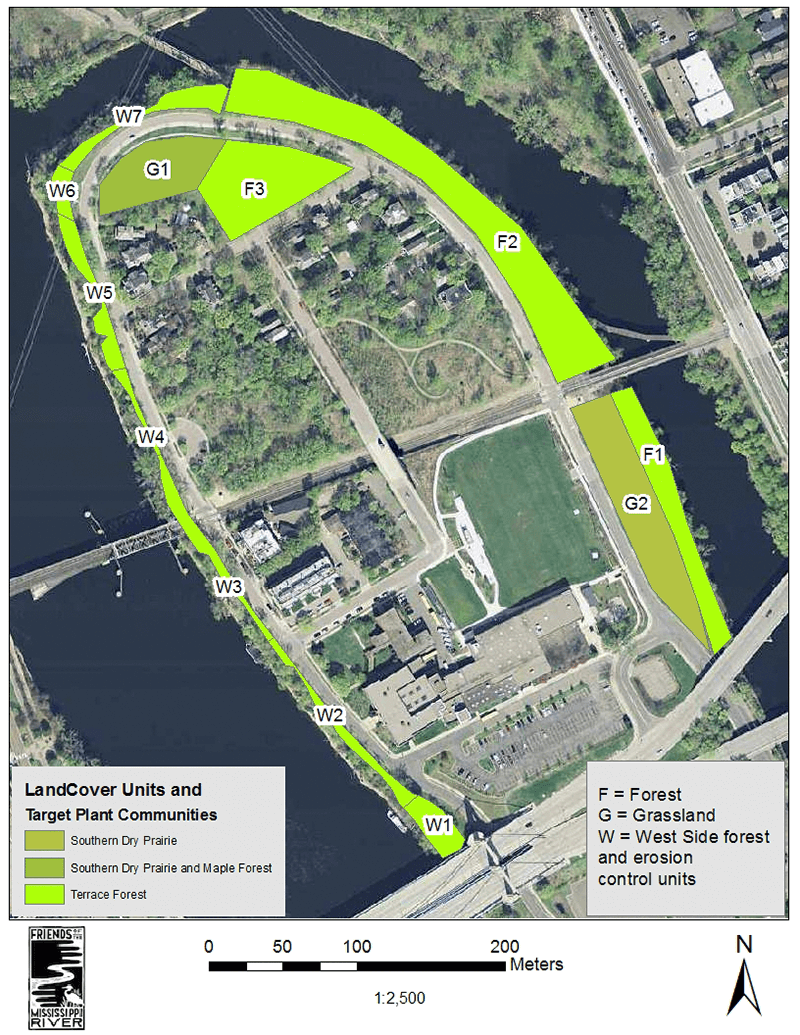The battle lines are drawn, and later this month, the Friends of the Mississippi River (FMR), the Minneapolis Parks and Recreation Board (MPRB) and Mississippi Watershed Management Organization (MWMO) will begin a campaign to rid Nicollet Island of a host of alien invaders – buckthorn, Siberian elm, honeysuckle and garlic mustard, to name just a few. The goal is to restore the island’s native prairie ecology and forests.
“Nicollet Island was a diverse environment,” Alex Roth, FMR ecologist, said at a June 25 meeting at DeLaSalle High School. Before European contact, he noted, the 47-acre island held not only prairie grasses, but oak trees, and sugar maples whose sap was tapped by the Mdewakanton Dakota.
Through a century and a half of industrialization and boom and bust economic cycles, the invaders crept in. Homeowners have introduced some of the aliens. Roth said tulips, iris and Japanese barberry have escaped from islanders’ backyards and ended up in places where they don’t belong. Mulberry trees drop their berries; they’re eaten by the two local fox populations. One resident said he’d seen mulberry seeds in the foxes’ scat, so the island’s fauna are also helping in the distribution of some of the unwanted plant species.
Fortunately, early explorers such as scientist Joseph Nicollet, who visited the St. Anthony Falls area in 1838, thoroughly documented the plant life they found on the island. “Even [Henry David] Thoreau noted the diversity of plants here,” said Roth. These historical records provide a blueprint for replanting native species.
The island has been divided into 12 sectors. Each has a slightly different ecology and will receive slightly different remediation techniques. For example, a sector on the north end of the island designated G1 is a degraded grass bed that contains smooth brome grass, Siberian elms and boxelder trees. Roth said this area won’t take as much work to transition it to a higher-quality prairie area as some of the more heavily wooded areas.
The MWMO is studying erosion caused by waves and ice on the lower slopes of the west side of the island. Here, MPRB would introduce terraced plantings. Plans also call for the installation of a 6-ft.-wide crushed limestone trail through the prairie restoration area, and bike easements and pedestrian walkways at the Merriam St. bridge.
Restoration work has already begun. Earlier this spring, the DeLaSalle High School Green Team, led by Tim Lynch, ripped out garbage bags full of garlic mustard. In the coming weeks, professional crews will come in and tear out the buckthorn, which has crowded out native plants beneath the trees, and thin out populations of green ash and boxelder trees which are little more than shrubs. The object is to allow more light under the tree canopy so that prairie grasses and wildflowers can be seeded.
After the trees and brush have been taken out (about a two-week process), the compacted soil will be loosened and amended so native plants can be seeded. This work will be done by volunteers. All of this work will take place on Park Board land around the island’s perimeter. Funding has come from grants from MWMO and the National Fish and Wildlife Foundation.
The first volunteer event will be a woodland planting this fall, bringing back those sugar maples. Next spring, volunteers will plant the prairie. If you’d like to participate, contact FMR volunteer coordinator Amy Kilgore, akilgore@fmr.org, 651-222-2193 x31.
When it’s all said and done, Nicollet Island will have a lighter, more airy feel. Water quality and wildlife habitat will have improved. And we’ll be able to see the river that surrounds it.
Below: This map outlines, in light greens, the areas that will be restored with native plant life. (Graphic provided by MPRB)
